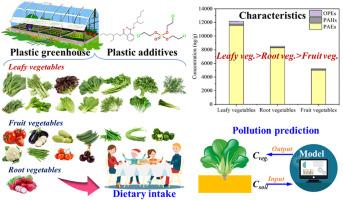中国东北塑料大棚蔬菜中邻苯二甲酸盐、有机磷酸酯和多环芳烃的特征、预测和风险评估。
IF 8.1
2区 环境科学与生态学
Q1 ENVIRONMENTAL SCIENCES
引用次数: 0
摘要
我们对中国东北地区 26 个塑料大棚的蔬菜及其相应土壤中邻苯二甲酸盐(PAEs)、有机磷酸酯(OPEs)和多环芳烃(PAHs)的污染情况进行了调查。蔬菜食用部分的 PAEs、OPEs 和 PAHs 含量分别为 2620-21800、115-852 和 32.4-602 ng/g,而大棚土壤中这些化学物质的含量分别为 5770-18800、196-935 和 109-1600 ng/g。PAEs 是温室中的主要有机污染物,比 OPEs 和 PAHs 高出 1-2 个数量级。叶菜类蔬菜的污染水平最高,是根茎类和果菜类蔬菜的 1-3 倍。化学物质的生物累积因子(BAFs)与其理化性质(如辛醇-水分配系数和有机碳分配系数)呈显著负相关。根据化学品在相应土壤中的浓度,分区限制模型可以在一定程度上准确预测温室蔬菜的污染水平。我们通过每天摄入温室蔬菜来评估目标化合物的危害商数,发现邻苯二甲酸二(2-乙基己基)酯的风险较低。这项研究强调了温室叶菜造成的潜在膳食暴露风险,并提出了一种通过土壤监测评估温室蔬菜风险的方法。本文章由计算机程序翻译,如有差异,请以英文原文为准。

Characteristics, prediction, and risk assessment of phthalates, organophosphate esters, and polycyclic aromatic hydrocarbons in vegetables from plastic greenhouses of Northeast China
We investigated the contaminations of phthalates (PAEs), organophosphate esters (OPEs), and polycyclic aromatic hydrocarbons (PAHs) in the vegetables and their corresponding soils from 26 plastic greenhouses of Northeast China. PAEs, OPEs, and PAHs in the edible portion of vegetables were in the range of 2620–21800, 115–852, and 32.4–602 ng/g, while the levels of these chemicals in the greenhouse soils were 5770–18800, 196–935, and 109–1600 ng/g, respectively. PAEs are the main organic pollutants in greenhouses, which were 1-2 orders of magnitude higher than that of OPEs and PAHs. Leafy vegetables showed the highest contamination level, which is ∼1–3 times that of root and fruit vegetables. Bioaccumulation factors (BAFs) of chemicals are significantly negatively correlated with their physicochemical properties, e.g., octanol-water partition coefficient and organic carbon partition coefficient. The partition-limited model can accurately predict the contamination level of greenhouse vegetables to a certain extent based on the chemical's concentration in the corresponding soil. We assessed the hazard quotients of target compounds through daily intake of greenhouse vegetables, and found a low risk for di(2-ethylhexyl) phthalate. This research emphasized the potential dietary exposure risks caused by greenhouse leafy vegetables, and proposed a method for evaluating the risk of greenhouse vegetables through soil monitoring.
求助全文
通过发布文献求助,成功后即可免费获取论文全文。
去求助
来源期刊

Chemosphere
环境科学-环境科学
CiteScore
15.80
自引率
8.00%
发文量
4975
审稿时长
3.4 months
期刊介绍:
Chemosphere, being an international multidisciplinary journal, is dedicated to publishing original communications and review articles on chemicals in the environment. The scope covers a wide range of topics, including the identification, quantification, behavior, fate, toxicology, treatment, and remediation of chemicals in the bio-, hydro-, litho-, and atmosphere, ensuring the broad dissemination of research in this field.
 求助内容:
求助内容: 应助结果提醒方式:
应助结果提醒方式:


